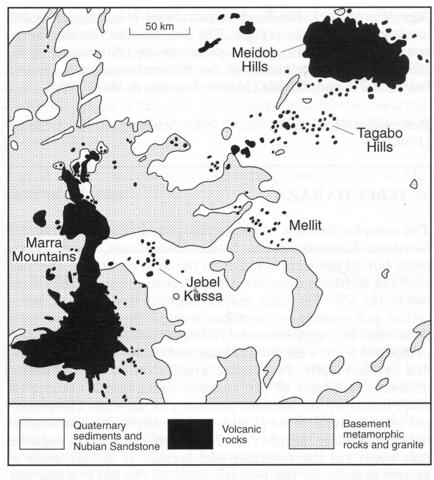stripes
The Meidob volcanic field covers a rectangular area of 100x70 km and can be divided into an elevated central area dominated by phonolitic and trachytic rocks which form lavas, pyroclastic flows, fallout deposits and maars, and a lower outer area formed mainly of basaltic lava flows and scoria cones (Franz et al., 1997). The total volume of volcanic products is estimated at 1,400-1,800 km2, of which some 98% are basaltic. Franz et al. (1997) identified 695 volcanoes of which 66% are scoria cones, 9% mesa flows, 7% maars and tuff rings and 19% composite cones and deeply eroded volcanic relicts. These authors discuss in some detail the volcanology of the various types of deposit and structures and present a number of measured stratigraphic sections. The more basic lavas include basanitic, hawaiitic and more rarely nephelinitic rocks in which there are phenocrysts of plagioclase, olivine and augite with green aegirine-augite cores. The groundmass includes amphibole, nepheline, biotite, alkali feldspar and apatite with glass in some phonolites. The groundmass of the trachytic and phonolitic rocks contains sanidine, anorthoclase, nepheline, aegirine-augite, olivine, biotite, amphibole and Ti-magnetite with phenocrysts of diopside and alkali feldspar. Wehrlite and olivine clinopyroxenite xenoliths occur in some pyroclastic deposits. Although Franz et al. (1997) do not give their chemical data they present numerous diagrams illustrating the chemical characteristics of the Meidob rocks including a total alkalis-silica diagram indicating the range of compositions. A very detailed study of a trachytic fall deposit from a tuff ring in the central part of the Meidob field will be found in Paulick and Franz (1997).
FRANZ, G., PUDLO, D., URLACHER, G., HAUSMANN, U., BOVEN, A. and WEMMER, K. 1994. The Darfur Dome, western Sudan: the product of a subcontinental mantle plume. Geologische Rundschau, 83: 614-23.FRANZ, G., BREITKREUZ, C., COYLE, D.A., EL HUR, B., HEINRICH, W., PAULICK, H., PUDLO, D., SMITH, R. and STEINER, G. 1997. The alkaline Meidob volcanic field (Late Cenozoic, northwest Sudan). Journal of African Earth Sciences, 25: 263-91.PAULICK H. and FRANZ, G. 1997. The color of pumice: case study on a trachytic fall deposit, Meidob volcanic field, Sudan. Bulletin of Volcanology, 59: 171-85.

